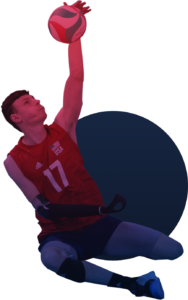Sitting Volleyball from A-Z
While a bit outdated (this was produced for the 2012 London Paralympic Games), this video gives a wide overview of sitting volleyball and its similarities to the standing game.
Resources for
Follow USAVolleyball
“Sitting is definitely much harder than standing volleyball. It’s a completely different game. You’re using different muscles… and you have to have quick reaction times; you can’t just get up, run and dive for the ball.”
Annie Flood Sitting volleyball is a discipline of the sport in which athletes play in a seated position. The sitting game utilizes the same volleyball skills and techniques as the standing game with a few key rule differences. Players use both their arms and legs to move across the court, and it’s a physical, fast-paced game. USA Volleyball is the official National Governing Body for sitting volleyball.
Sitting volleyball is a discipline of the sport in which athletes play in a seated position. The sitting game utilizes the same volleyball skills and techniques as the standing game with a few key rule differences. Players use both their arms and legs to move across the court, and it’s a physical, fast-paced game. USA Volleyball is the official National Governing Body for sitting volleyball.
Sitting volleyball has been part of the Paralympic Games since the men’s competition debuted at the Arnhem Games in 1980.
Similarities
Differences
Anyone can play! But if you want to play on the U.S. National Team or in the Paralympic Games, there are classifications for competition.
In such competition, players are required to have a qualifying disability as determined two medical classifiers, who measure an athlete’s functional loss. Based on this evaluation, an athlete may be classified as Minimal Disabled (VS2) or Disabled (VS1).
A VS2 athlete has lost some muscular strength, flexibility, or a combination, in a joint that hinders the athlete’s ability to play volleyball. A VS1 athlete has lost complete muscular strength, flexibility, or a significant combination of the two in a joint.
Teams competing in official international competition are permitted to have a maximum of two VS2 athletes on the roster and can only play one at a time.
There are a number of programs across the country each year.
Florida Region
Conducts open clinics to introduce people to playing, officiating and coaching sitting volleyball as well as fields a sitting team to compete at the USAV Open Nationals.
Contact: [email protected]
GEVA Region
The Garden Empire Volleyball Association runs sitting volleyball programs open to those with physical limitations and those without.
Contact: [email protected]
Northern California Region
Leagues, clinics and more! Northern California continues to support sitting volleyball and to reach out to those with physical limitations and those without.
Contact: [email protected]
Have a question? Interested in learning more?
Contact Bill Hamiter at [email protected].
To inquire about trying out for the national sitting teams, use the contacts below.
While a bit outdated (this was produced for the 2012 London Paralympic Games), this video gives a wide overview of sitting volleyball and its similarities to the standing game.
USA Sitting Volleyball
100 North University Drive, Box 99
Edmond, OK 73034
Bill Hamiter
[email protected]
Greg Walker
[email protected]
Michelle Goodall
[email protected]
Laura Fawcett
[email protected]
FOS vs. J & K in 2019 features members of the U.S. Sitting National Teams in action outside of their Team USA uniforms.